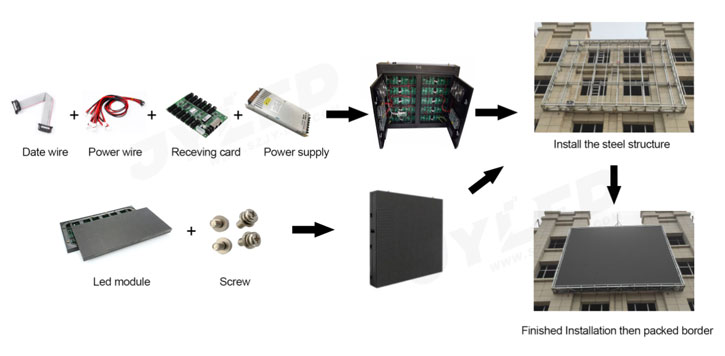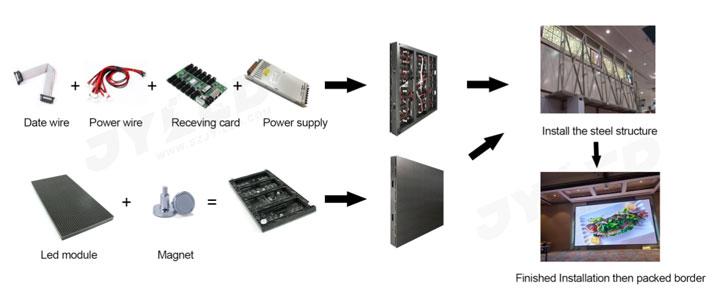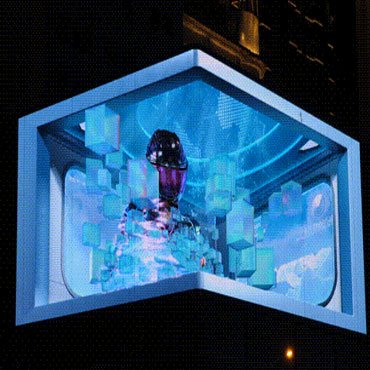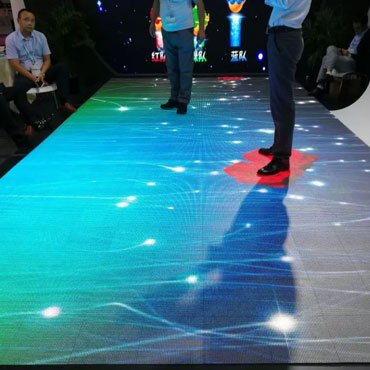First, The main composition of the LED display (taking a more complex synchronous full-color screen as an example)
- Metal structure frame:its function is to form the inner frame, carry various circuit boards such as display unit boards or modules, and switching power supplies
- Display unit: It is the main part of the LED display, which is composed of LED lights and driving circuits. The indoor screen is the unit display board of various specifications, and the outdoor LED display is the module box.
- Scanning control board: The function of this circuit board is data buffering, generating various scanning signals and duty ratio grayscale control signals.
- Switching power supply: convert 220V alternating current into various direct currents to provide various circuits.
- Transmission cable: The display data and various control signals generated by the main controller are transmitted to the screen by twisted pair cables.
- Main controller: buffer the input RGB digital video signal, transform grayscale, reorganize, and generate various control signals.
- Special display card and multimedia card: In addition to the basic functions of a computer display card, it also outputs digital RGB signals and signals such as line, field and blanking to the main controller. In addition to the above functions, multimedia can also convert the input analog Video signal into a digital RGB signal (ie, video capture).
- Computer and its peripherals

Second, the main function module analysis
Video broadcast
Through multimedia video control technology and VGA synchronization technology, various forms of video information sources can be easily introduced into the computer network system, such as broadcast TV and satellite TV signals, camera video signals, VCD video signals, computer animation information, etc. Implement the following functions:
- Support VGA display, display various computer information, graphics and images.
- Support various input methods; support PAL, NTSC and other formats.
- Real-time display of color video images to achieve live broadcast.
- Rebroadcasting of radio, satellite and cable television signals.
- Instant playback (VCR, VCD, DVD, LD) of video signals, etc.
- It has the function of playing pictures and texts with different ratios of left and right at the same time.
Computer broadcast
- Graphic effects display function: It has the functions of editing, zooming, flowing and animation for graphics and text.
- Display a variety of computer information, graphics, images and 2, 3-dimensional computer animation and overlay text.
- The broadcasting system is equipped with multimedia software, which can flexibly input and broadcast various information.
- There are a variety of Chinese fonts and fonts to choose from, and you can also input English, Spanish, French, German, Greek, Russian, Japanese and other languages.
- There are a variety of broadcasting methods, such as: single/multi-line panning, single/multi-line up/down, left/right pull, up/down, rotation, stepless zoom, etc.
- Editing, and playback of announcements, and news are posted instantly, with a choice of fonts.
Network function
- Equipped with a standard network interface, it can be connected to other standard networks (information inquiry system, municipal publicity network system, etc.).
- Collect and broadcast real-time data of each database to realize remote network control.
- Access to the Internet through the network system, With a sound interface, it can be connected to audio equipment to achieve sound and image synchronization.
Screen controller
The screen controller controls the display effect of its corresponding LED screen. It can automatically run a continuous cycle program to obtain relevant display data according to a given program list, and it can also manually intervene to generate the display effect on the screen. The pixels on the screen and the pixels on the corresponding area of the screen controller display – corresponding, direct mapping.
The screen controller can manually adjust the brightness of the display screen and select the grayscale nonlinear correction data suitable for the current environment. The screen controller can also automatically adjust the display screen brightness and select different grayscale nonlinear correction data according to the environmental brightness through the network system. .
The contrast, chromaticity, etc. of the image display can be adjusted through the screen controller. The screen controller transmits the information to be displayed to the video processing and control unit for video processing.
Video processing and control unit
The video processing and control unit performs image processing of the display data, including:
- The second-level grayscale nonlinear correction can be adjusted automatically or manually.
- Automatic or manual stepless brightness adjustment.
- The gray level control system can control the display screen to display 24-bit data of 8 bits for each primary color, that is, 256 gray levels for each primary color.
- Image noise reduction processing to ensure a cleaner and smoother image.
- Image enhancement technology, image edge enhancement technology.
- Motion compensation technology, chromaticity adjustment function.
Visual processing
- In the system, the brightness of each primary color of a single module can be adjusted separately, the color balance can be adjusted, and the mosaic phenomenon can be basically eliminated.
- The brightness consistency of all modules and display modules is good, and the monochrome display has no visual difference.
- The video processing and control unit transmits the processed display information to the communication module for long-distance transmission to the display screen.
Communication module
The communication module ensures that the display content of the screen controller is transmitted to the LED display screen accurately and over a long distance.
The communication module encodes and decodes the transmitted information, performs long-distance transmission and receives data processing. The communication module transmits the display information to the data distribution and scanning unit.

Three, The main working principle of the display screen
The LED display is usually composed of a main controller, a scanning board, a display control unit and an LED display body. The main controller obtains the brightness data of each pixel of a screen from the computer display card, and then assigns it to several scanning boards.
The board is responsible for controlling several rows (columns) on the LED display, and the LED display signals on each row (column) are cascaded and transmitted through each display control unit in the row in a serial manner, and each display control unit directly faces the LED display body. The work of the main controller is to convert the signal of the computer display card into the data and control signal format required by the LED display.
The function of the display control unit is similar to that of the image display screen, which is generally composed of a shift register latch with a grayscale control function. It’s just that the scale of video LED displays tends to be larger, so an integrated circuit with a larger integrated scale should be used.
The function of the scanning switch is the so-called link between the previous and the next. On the one hand, it accepts the video signal of the main controller, on the other hand, it transmits the data belonging to this level to its own display control units, and at the same time, it also sends the data that does not belong to this level downward.
A cascaded scan pool transmission. The differences in space, time, sequence and other aspects of video signal and LED display data need to be coordinated by a scanning board.




